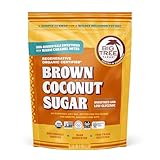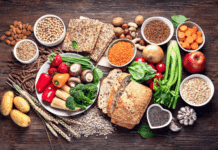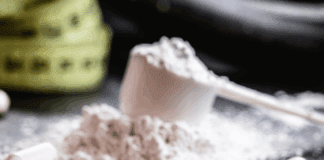Key Takeaways
-
What it is: A granulated sweetener made from the sap of the coconut palm flower (not from coconut flesh). Also called coconut palm sugar.
-
Processing: Sap is heated to evaporate water and crystallize—minimal refinement compared to white sugar.
-
Taste/use: Mild caramel/toffee notes; 1:1 swap for white or brown sugar in most recipes.
-
Glycemic Index (GI): Often reported around ~35 (low to medium), but values can vary by brand, method, and serving size. Treat as added sugar nutritionally.
-
Nutrients: Contains minute amounts of potassium, zinc, iron, and inulin (a prebiotic fiber)—but not enough to drive health benefits at typical use.
-
Health: It’s not a health food; it’s simply a less-refined sugar option with a slightly different composition and flavor.
-
Keto? No—it’s primarily sucrose (glucose + fructose) and not keto-friendly.
-
Best use cases: Coffee/tea, baking (cookies, muffins, quick breads), sauces, and marinades where a gentle caramel flavor helps.
What Is Coconut Sugar?
Coconut sugar (aka coconut palm sugar) is a crystalline sweetener produced from the sap of the coconut palm (Cocos nucifera) flower bud. The collected sap is heated to evaporate water until it thickens (like a syrup) and then crystallizes. The crystals are ground into granules resembling light brown sugar.
-
Flavor: Light caramel, butterscotch, and mellow molasses notes
-
Color: Light to medium brown (varies with heating time)
-
Solubility: Dissolves well in hot and cold liquids; browns similarly to cane sugar
How Coconut Sugar Is Made
-
Tapping the flower bud: Farmers cut/score the coconut palm inflorescence to drip sap into containers.
-
Filtering: Sap is strained to remove debris.
-
Heating: Sap is gently heated to reduce moisture.
-
Crystallizing & drying: Concentrated syrup is stirred until crystals form, then dried.
-
Grinding & sieving: The Dried solid is ground to uniform granules.
Minimal processing preserves trace compounds that give coconut sugar its color and flavor. No bleaching.
Nutrition Facts & Composition
Per 1 tsp (4 g) (typical label values; vary by brand)
-
Calories: ~15–16
-
Total carbohydrate: ~4 g (Sugars ~4 g)
-
Protein/Fat: 0 g
-
Minerals: trace amounts of potassium, zinc, iron (not clinically meaningful at normal servings)
-
Fiber: Trace inulin (may slightly affect GI and gut microbiota, but amounts are small)
Bottom line: It’s still sugar. The “extra” nutrients are not present in amounts that would offset the metabolic effects of added sugar.
Glycemic Index & Blood Sugar
-
Coconut sugar’s GI is commonly reported near ~35 (low–medium), but methods and batches differ, and portion size matters.
-
Composition is mostly sucrose, which splits into glucose and fructose during digestion.
-
Practical take: If you’re managing blood glucose, treat coconut sugar as an added sugar—watch total grams and serving size.
Tip: Pair with fiber, protein, and fat in meals to blunt rapid spikes.
Is Coconut Sugar Good for You?
Short answer: It can be a tasty, less-refined alternative, but it’s not a health food.
Potential pros
-
Milder GI (as reported) than refined white sugar
-
Caramel flavor can reduce total sweetener needed in some recipes
-
Less refined; tiny amounts of minerals/inulin remain
Cons
-
Still calorie-dense sugar; overuse contributes to excess calories, tooth decay, and metabolic risk
-
Not meaningfully more nutritious than cane sugar at normal serving sizes
-
May be more expensive than white/brown sugar
Who might consider it?
Cooks/bakers who like natural, minimally processed sweeteners and want a gentler flavor or possibly a lower GI profile—while still limiting total sugar intake.
Coconut Sugar vs Cane Sugar (and Others)
Quick Comparison Table (typical values; vary by brand/batch)
| Sweetener | Calories (per tsp) | Carbs (g) | Reported GI* | Main Sugars | Flavor Notes | Good For |
|---|---|---|---|---|---|---|
| Coconut sugar | ~16 | ~4 | ~35 | Mostly sucrose | Caramel/toffee | Baking, coffee, sauces |
| White cane sugar | ~16 | ~4 | ~63 | Sucrose | Neutral | Universal sweetening |
| Brown sugar (cane) | ~16 | ~4 | ~64 | Sucrose + molasses | Deeper molasses | Cookies, BBQ rubs |
| Honey | ~21 | ~5.7 | ~58 | Fructose + glucose | Floral, complex | Tea, glazes |
| Maple syrup | ~17 | ~4.5 | ~54 | Sucrose + others | Maple/caramel | Pancakes, baking |
| Date sugar | ~15–16 | ~4 | ~35–55 | Glucose/fructose + fiber | Fruity/caramel | Dense bakes |
| Stevia (pure) | 0 | 0 | ~0 | Glycosides | Slight herbal | Drinks, cold desserts |
| Monk fruit (pure) | 0 | 0 | ~0 | Mogrosides | Clean sweet | Drinks, baked goods with bulking |
*GI values are approximate and vary by methodology and serving; use as directional only.
Coconut Sugar vs Cane Sugar:
-
Taste: Coconut sugar is softer, caramelly, great where brown sugar works.
-
GI: Often cited as lower than white cane sugar, but treat with caution.
-
Nutrition: Differences exist but are nutritionally minor.
Coconut Sugar vs Palm Sugar:
-
“Palm sugar” can come from various palms (date, palmyra, aren). Coconut sugar is from coconut palm sap—labels sometimes use the terms loosely. Choose transparent labeling (100% coconut palm).
Is Coconut Sugar Keto?
No. It’s high in net carbohydrates and will disrupt ketosis. For keto or very low-carb diets, use non-nutritive sweeteners (e.g., stevia, monk fruit blends, allulose, erythritol) in recipes designed for them.
How to Use It (Baking & Cooking)
General substitution: Start with 1:1 for white or brown sugar. Because coconut sugar is slightly less sweet and brings caramel notes, you can often reduce total sugar by ~10–15% without hurting texture.
Baking tips
-
Creaming: Works similarly to brown sugar; expect a slightly darker crumb.
-
Moisture: If a batter seems dry, add 1–2 tsp milk or water per cup of coconut sugar.
-
Color: Browning happens a bit faster; reduce oven temp by ~5–10 °C if edges darken too quickly.
-
Yeast doughs: It feeds yeast; flavor leans malty/caramel.
Great use cases
-
Cookies & muffins: Oatmeal, chocolate chip, banana muffins
-
Sauces & glazes: Teriyaki, BBQ, peanut sauce
-
Beverages: Coffee, chai, cocoa
-
Savory balance: Chili, curries, tomato sauces (to cut acidity)
Simple swap examples
-
Brown sugar: Use coconut sugar 1:1 (add 1 tsp molasses per cup if you want deeper molasses flavor).
-
White sugar in cookies: Use coconut sugar 1:1, then taste; optionally reduce by 10% next batch.
Buying, Quality, and Storage
-
Look for: “100% coconut blossom/palm sugar,” single-ingredient, no fillers (sometimes blends include cane sugar—check label).
-
Grind: Fine, uniform granules dissolve more evenly.
-
Organic/Fair-trade: Optional but supports better sourcing.
-
Storage: Airtight jar/bag, cool/dry, away from steam. If clumped, blitz briefly in a processor.
Sustainability & Ethics
Coconut palms can produce sap year-round, potentially offering stable income for smallholders. Impacts vary by region and farm practices. Favor brands with transparent supply chains, fair labor, and agroforestry practices.
FAQs
What is coconut sugar?
A minimally processed sweetener made by heating and crystallizing the sap of the coconut palm flower.
Is coconut sugar good for you?
It’s not a health food. Consider it a tasty, less-refined sugar with similar calories and carbs to cane sugar. Use sparingly.
Is coconut sugar healthy compared to white sugar?
It may have a lower reported GI and trace nutrients, but differences are small at normal servings. Health impact still depends on total sugar intake.
Is coconut sugar better than cane sugar?
Flavor and processing differ; nutritionally, they’re more alike than different. Choose based on taste, recipe, and preference, while limiting added sugar overall.
Is coconut sugar keto?
No. It’s high in net carbs and not keto-friendly.
Coconut sugar vs cane sugar—what’s the GI?
Coconut sugar is often reported around ~35 vs white sugar around ~63. Treat GI as approximate; prioritize portion control.
Does coconut sugar contain coconut allergens?
It’s made from sap, not coconut flesh. Allergies are unlikely but possible; check with your healthcare professional if concerned.
Can I use it in coffee?
Yes—its caramel note pairs well with coffee, chai, cocoa.















